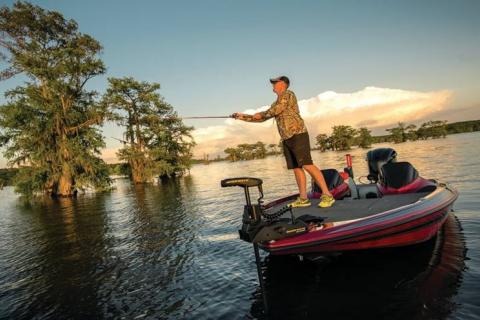
Fishing has long been known as a game of stealth. Putting yourself in the optimum position for making that next cast (while being extra quiet) can also lead you on your way to a hearty bend in the rod. These two characteristics are what make trolling motors a godsend for the fishing fraternity. Not only can anglers have total control over their craft at all times, they can also move effortlessly from spot to spot, and ultimately put more fish in the boat. Come and jump on the trolling motor  bandwagon, and find out which is the right pick for you and your boat.
bandwagon, and find out which is the right pick for you and your boat.
Importance of Thrust to Move Through the Water
Trolling motors, or electric motors, use battery power in order to propel a boat. The amount of power or strength needed to move through the water is described as "pounds of thrust." This power rating is common to all motors on the market, and is one of the most important aspects to consider when selecting the right unit to match your craft. With insufficient power behind you, working your boat through wind, high waves or weedy conditions can be all but impossible.
Tip: Watch Video: Get to know Minn Kota i-Pilot and change the way you fish.
Many factors fall into the equation when deciding on the necessary power needed for optimum performance. Some common questions to ask yourself are: Is your boat heavy, and what is the length? Do you store a lot of gear, or fish with more than one person? Do you fish in adverse conditions, such as high winds and rough  water?
water?
The minimum thrust chart on the right details the minimum amount of thrust required depending on the size of your craft.
Click here for a larger view of the thrust required for your boat length chart.
This chart is meant to convey "normal fishing conditions." If you answered "yes" to any of the previous questions I posed, moving up to the next level of thrust is highly recommended. If your boat, gear, and passengers are extremely heavy, going to a motor with even more thrust would be your best bet.
Many professionals believe that the best rule of thumb is to buy the biggest motor you can afford, all within reason of course. (A big, overpowering motor can also offer disadvantages if it literally "dwarfs" the size of your boat.) Choose wisely and weigh all of the variables. Running a motor that is under rated for your craft can only lead to misery and headaches when venturing out on the water.
Tip: 5 Ways to Make a Trolling Motor Last
Trolling Motor Voltage & Batteries
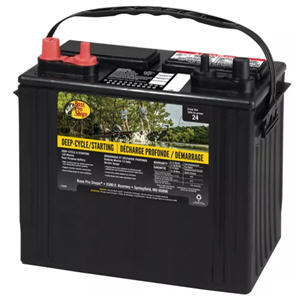
12V Marine Dual-Purpose Battery
Electric trolling motors come in three separate power systems: 12, 24 or 36 volts. To make it easier to understand, a 12-volt trolling motor is run off of one 12-volt deep cycle marine battery. In order for a 24-volt motor to work, it must be run off of two separate batteries, and a 36-volt version requires three.
A 12-volt trolling motor is the most inexpensive and easiest to run. It does, however, lack the staying power and thrust that the other two provide. A 24- or 36-volt system will allow the angler to fish longer periods out on the water, as they draw lower amps while providing increased thrust for more power.
If your boat is 16-foot or smaller, a high-thrust 12-volt model will be adequate for the conditions that you will face. If your boat is any longer, moving up to a 24- or 36-volt system is the only way to go for hassle-free boating.

Be certain not to scrimp and save on the batteries. Buying a high quality, deep-cycle marine battery (some are designed specifically for electric motors) will ensure that you are receiving the maximum power and longevity that is on the market. This will provide piece of mind in case you ever find yourself stranded out on the lake, nursing an overheated or blown outboard motor that just won't fire up!
Which to Choose, Bow or Transom Trolling Motor?
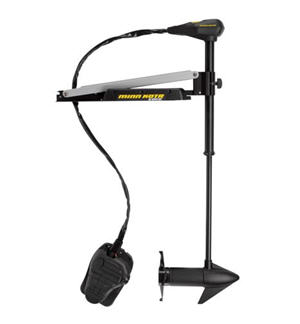
Control Bow-Mount Trolling
Motor
There are two kinds of trolling motors available: a bow mount trolling motor (installed at the front of the boat), and a transom mount trolling motor (manufactured for the back). In order to install a bow mount, you must have sufficient room up front, as well as a mounting bracket or plate to affix the housing. You must also have a flat bottom platform to fish from in order to make the set-up feasible.
A transom motor simply clamps onto the stern of the boat and will work with any style of craft.
A bow-mounted motor will provide superior maneuverability and better control, allowing the angler to fish easier and more efficiently. (This increase in maneuvering ability is due to the fact that bow-mounts "pull" your boat through the water, in comparison to a transom "pushing".) If your boat is 14-foot or larger and can accommodate a bow-mount, most certainly go that route. You won't regret it.
For small boats, dinghies and canoes, a transom mount would be the best choice. These motors work great for general positioning and trolling application — exactly what they were designed for. Whatever you decide, owning any kind of trolling motor is definitely better than not.
Do you Choose a Hand or Foot Control Trolling Motor?
If you decide to purchase a bow mount motor, the next decision to make is whether to operate it by hand or foot. Although both have their merits, trying each version and finding which is most comfortable to use is probably your best bet. The following chart outlines some advantages and disadvantages for both:
Click here for a larger view of the chart showing trolling motor type advantages and disadvantages.
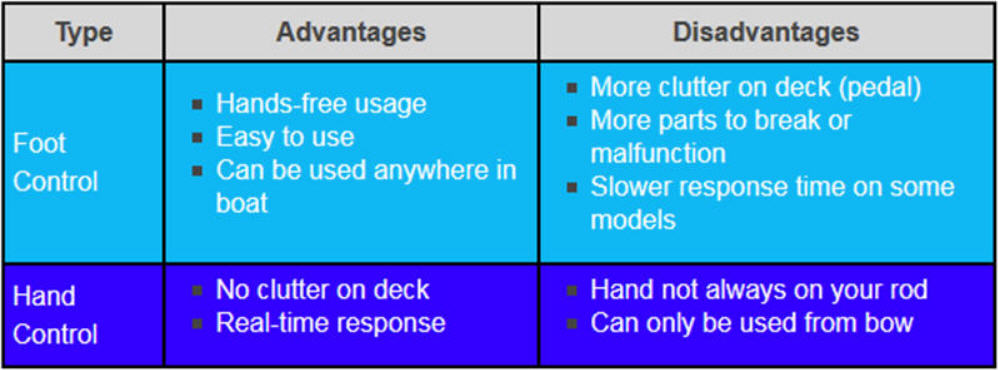
My personal preference is for the foot-control model, as this allows me to have a completely hands-free fishing experience. Some will argue that the hand control outweighs the merits of the foot. Taking the time to talk to different users of both models will enable you to figure out which is best for you.
Whatever version of motor you choose, both will require practice on the water in order to become comfortable with them. Once you do, however, the possibilities are endless.
What Type of Trolling Motor Shaft Length is Right?
Shaft length is important for optimum control of your boat. If the shaft chosen is too short, the prop may not be sufficiently submerged during rough or adverse conditions. If it is too long, shallow water operation may pose a continuous problem. Finding the appropriate length for the size of craft you own will ensure safe and carefree boating.
The shaft length is dictated by the height of the bow or stern. Deep V boats will require a longer shaft, whereas the shortest length will adequately serve canoes.
Trolling Motor Features You Should Consider
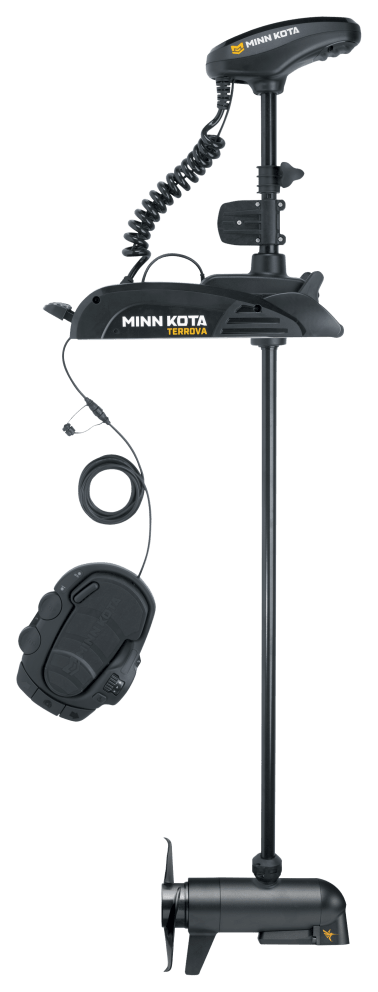
Technology is expanding in the land of the trolling motor, and new features and wrinkles become available annually. Here are a few that are worth checking out:
Built-In Battery Gauge — Some models of trolling motors have battery gauges built in to the housing or head of the unit. This gauge will allow an angler to quickly and easily check how much power is left in the battery itself, making it a no-brainer for estimating fishing time left or when to clamp the charger on.
Digital Displays — High-end models are now coming standard with digital screens, complete with readouts of speed and depth. Although these motors come at a price, the technology is certain to put you on more fish.
Self-Directional Motors — An interesting feature, in that it allows total hand and foot-free operation, and will follow shorelines or depth contours on its very own using GPS coordinates. It will even steer you in a straight line when the winds are howling!
Tip: Self-directional trolling motors allow anglers more time to fish.
iPilot and Smart Remote Control Trolling Motors — Another interesting feature, in that you're using real-time GPS controlled from your mobile phone or RC unit.
Tip: A popular and highly rated by customers self-directional motor is the Minn Kota Ultrex Bow Mount Trolling Motor with i-Pilot US2 found at Bass Pro Shops here.
Here are a few more things to look for when making your final decision:
- Composite or stainless steel shaft will endure shock and stand up to abuse much better than weaker metals.
- Make sure the prop is weedless, and that replacement blades are available for your specific model.
- Ensure that the mount is heavy duty and strong. The less plastic parts it has, the better.
- If you plan on using the foot-control pedal from anywhere in the boat, make sure the cable is sufficient in length for the size of your craft.
Trolling motors add a completely new dimension to fishing. Perfecting boat control, fishing inaccessible areas and maintaining a silent approach will ensure added enjoyment and more fish for the angler willing to experiment. Shop around, take each style for a test drive and pay attention to detail — banner days on the lake await you.
- 351808 views

